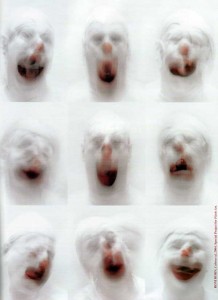For ‘Flash Art’ magazine
They’re jarring, garish, disturbing and…they’re portraits of us. Roni Horn’s clown photographs are a departure from previous projects, more provocative than the stony-faced Icelandic woman in ‘You Are the Weather’ (1996) or the roiling surface of the River Thames in ‘Still Water’ (1999). Nevertheless, they’re still intended to make her audience reflect on its own response to the work. As Horn explained in a discussion with Merrily Kerr, the viewer’s experience is paramount, even more important to her than the aesthetic aspects of the photographs and sculptures themselves. Acting as ambiguous symbols, the clowns lead viewers to analyze their process of looking and the reactions that arise.
MK – In the book format of ‘Cabinet of’ you see the clown’s face one image at a time, while this project for Flash Art is arranged in a grid. How will the viewer’s experience be different?
RH – I originally conceived of it as a grid on one wall. When I had the working photographs up for the pieces I did with Dia, they hadn’t been color corrected or scaled, but that’s how I had them on the wall – going 12 feet up. I thought, it’s very harsh [and] really aggressive, but it has a quality that interests me. I’ve [also] installed it as a surround like ‘You Are the Weather’. Sometimes a work has more than one option in terms of the kind of relationship it can have with the viewer. Book form offers a very different experience than an ‘in the round’ experience. I’m interested in these differences. So I often work in dual forms.
MK – The viewer’s experience is the goal of your work, right?
RH –There is no other point for me. There is no other reason to involve an audience unless you’re dealing with the quality of the experience you’re putting out there.
MK – You’ve been quoted as saying that you don’t consider yourself a visual artist. Could you explain?
RH – The thing is, I prefer not to be anything, because then I keep all my options. Once I say what I am, then it’s like excluding everything else. So why bother saying it? I don’t think most of my work comes from the visual. It starts in a more conceptual realm and the visual precipitates out of it. Language is a big factor in the development of the work. It’s kind of pre-visual.
MK – Speaking of language, you often talk about Emily Dickinson’s writing in relation to your work.
RH – There is something in the way that Dickinson uses language that allows me to cultivate the idea of presence around it. And that’s what I’m doing with those objects [text sculptures]. When I think of language it’s an intangible form. Language is, to some extent, a philosophical device or mind device. It’s based in the need to express or communicate, perhaps, but there is this interesting amalgam that occurs in Dickinson that is both of language and of actuality.
She, for whatever reason, in a very isolated fashion, was having this extraordinary dialogue with the empirical – what was in front of her. Basically, I’m amplifying her implications. [It relates to] that idea of language in Jewish culture which is really a substitute, in part, for not having access to the graven image. So there is an element of that in where these pieces come from. They are views in a room. What I mean by that is that when you look at it, you have to enter another space to have that experience. And that other space is the vertical dimension of what it says and where that takes you. In the sense of your understanding where that takes you. And that is all yours.
MK – Does ‘Cabinet of’ challenge viewers to look for the experience instead of musing on the clown imagery?
RH – ‘Cabinet of’ is a kind of self-portrait, definitely. But, it’s a self-portrait of the person looking at the work. And that’s the way I see it. Clown is just a metaphor for mirror. Because what a clown originally functioned as was an amoral symbol enabling viewers to imagine themselves in these roles or to understand their own morality through the clown figure, which was a kind of symbolic form. You could say it’s a generic portrait of humanity or you could imagine it as a self –portrait of the viewer expressed through the clown image – these are the same thing.
Basically, the clown thing isn’t what interested me originally. Not historically [but] more in the idea of appearance. The clown is not about actuality. It’s the opposite, it’s of appearance; it’s a symbol. And the cloud, all it is is appearance; it’s moisture and air. Now this isn’t very interesting to me to break the thing down that way, but really, the two objects are immaterial realities. One in the fabric of nature and the other in the fabric of humankind, but both functioning exclusively through appearance. They have no other life. So that was how they came together. ‘Cabinet of’ came out of that and that obviously is connected to ‘Cabinet of Dr Caligari’ the film. It’s again, not literal, but every cabinet is an interior of some kind.
MK –Your work requires viewers to have a degree of self-knowledge. Are people able to be that self-aware?
RH – I have to work, in a way, with these assumptions about my audience. Because these are the things I value and seek to embody or activate. I think a lot of people won’t. A lot of people will see an object and they’ll go on to the next show. It’s about individual character and what moves you. I think the work acts more as a mirror for one’s limitations or one’s potential. I’m not trying to educate, I’m not trying to communicate or impose my morality. This is what I have to do.